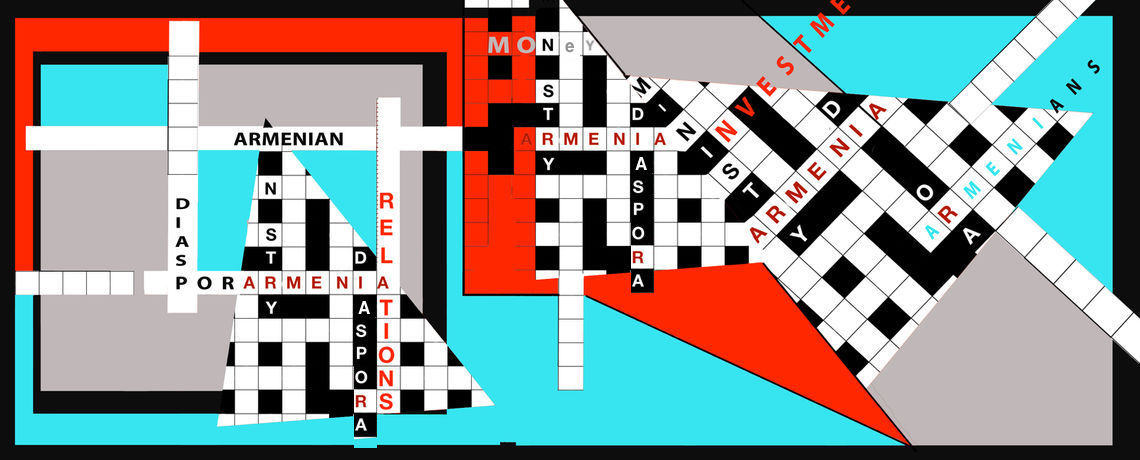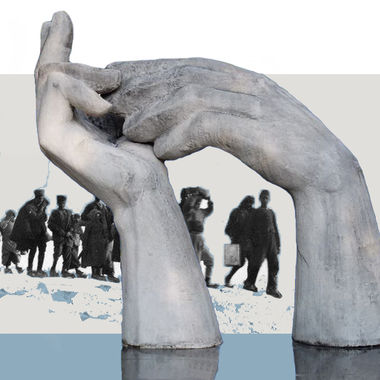Thu Jan 17 2019 · 10 min read
The Elimination of the Diaspora Ministry has Nothing to do With the Diaspora

By Nerses Kopalyan

Ineptitude is perhaps the best term in explaining the way Armenia’s Ministry of Diaspora has operated since its formation in 2008. Being the personal bureaucratic fiefdom of then-minister Hranush Hakobyan, the Ministry not only failed miserably to accomplish any of its broader objectives, but more problematically, it actually became counter-productive in formulating a healthy relationship with Armenia’s vast Diaspora. Bureaucratically irrelevant, functionally dysfunctional, and structurally incoherent, the purpose of having a Diaspora Ministry has sounded grand, but its actual existence has been everything but.
This perspective appears to garner much consensus from both internal observers within Armenian society as well as the Diaspora: everyone and everything has complained about the incompetence and, again, the ineptitude of this Ministry. In this context, it is a bit baffling that a broad range of Diasporan voices have displayed dismay, confusion, or misconstrued criticism at Armenia’s new government for implementing plans to eliminate, among four other ministries, the Ministry of Diaspora. Failing to genuinely understand the underlying objectives of this move, most Diasporan critics have relied on a knee-jerk reaction: the elimination of the Diaspora Ministry is directly and indirectly against the interests of the Diaspora. What they fail to cogently understand is that the elimination of the Diaspora Ministry has absolutely nothing to do with the Diaspora. Why? Because the Diaspora Ministry never served the interests of the Diaspora in the first place; that it could have is besides the point.
Diasporan observers have, for the longest time, held the misconception that the Ministry of Diaspora was formed for Diasporan Armenians. The reality has actually been the opposite: the Sargsyan Administration formed the Ministry in order to more officially and formally pose a simplistic question: What can the Diaspora do for Armenia? The relationship has not only been continuously one-sided, but it has also been unconstructive: there has been very little, if any, endeavors by the Ministry to serve, advance, or even consider the interests of the Diasporan communities. Reducing the Diaspora into the anecdotal wealthy uncle, the Ministry’s primary objective was to “milk” as much money as it could from the Diaspora, whether it was through underdeveloped investment propositions, philanthropy projects that lacked accountability or oversight, or just a simple, and at times shameless, encouraging of more remittances. In its totality, not only did the Ministry of Diaspora not serve the interests of the broader Armenian world, it also did not serve its bureaucratic purpose as a functional part of government. Simply put, this Ministry sounded good on paper, but has had very little substance in practice.
In the wake of the Velvet Revolution, in came the Pashinyan Administration, inheriting a Ministry that had lost the one thing that defined it: the trust of the Diaspora. In essence, how can we speak of a Ministry of Diaspora, when the Diaspora, itself, has forsaken it?
Whereas the Diaspora Ministry was to serve as a form of concierge to the global Armenian community, directing investments, guiding repatriation, and building social and cultural bridges between Armenian and Diasporan communities, it actually did the opposite; it disheartened interested investors who were not “connected,” developed a dismal reputation in the Diasporan communities, and bureaucratically, it overlapped and contradicted the activities of the Foreign Ministry.
In the wake of the Velvet Revolution, in came the Pashinyan Administration, inheriting a Ministry that had lost the one thing that defined it: the trust of the Diaspora. In essence, how can we speak of a Ministry of Diaspora, when the Diaspora, itself, has forsaken it? In the remaining six months of the Pashinyan Administration (up to the December 9 Parliamentary snap elections), the Diaspora Ministry did its utmost to achieve one major objective: regain the trust of the Diaspora. Newly-appointed Minister Mkhitar Hayrapetyan undertook a whirlwind tour of the major Armenian Diasporan communities, meeting leaders, consulting with the communities, and seeking to re-establish trust in the Homeland. That these efforts were met with skepticism cannot be denied; that the Diaspora cannot be blamed for this skepticism also cannot be denied: this paradox remained at the heart of the problem. Flanked by his competent Deputy Minister Babken DerGrigoryan, the Ministry audited and corrected the problems of the previous administration, introduced various policy proposals for change, and replaced the mismanaged Take a Step Home program with a revitalized My Step Towards Home program, as well as introducing the Neruzh Diasporan Youth Startup program. Collectively, these programs did not generate the necessary outcomes or substantive outputs anticipated. The Ministry of Diaspora no longer worked: it was too broken and too devalued.
The elimination of the Ministry, then, is not, in any way, an indictment of Armenia’s Diaspora, the Diaspora’s effort to support the Homeland, or the Diaspora’s future potential to greatly contribute. That is, the elimination of the Ministry had nothing to do with the Diaspora! That being said, a new question begs itself: what institutional mechanisms will the new government utilize or implement to continue, develop, and grow its relationship and possible integration with the Diasporan communities?
Noting the Diaspora’s important role in developing and implementing large body of projects in the country, there is mutual consensus that the Diaspora has invested heavily in Armenia, but has received very little in the way of returns on these investments. These returns, of course, are not monetary; this is not what the Diaspora wants.
While not to suggest that the Pashinyan Administration has been clueless, but they have not, at the same time, provided any well-structured propositions. Tentatively, the Pashinynan Government has floated two generic suggestions. The first notes that the Ministry of Foreign Affairs will have a separate department within the Ministry which deals with Diasporan relations, thus allowing for bureaucratic coherence. Second, it has suggested that the Office of the Deputy Prime Minister will also be directly involved in cultivating and improving Diasporan relations. Both of these suggestions are obviously positive, and indicate the high-level of importance placed on this issue: the Deputy Prime Minister will deal with Diasporan issues, not simply a minister. But this, in of itself, does not suffice according to my analytical assessment of Armenia’s governmental structure and the need for broader and more inclusive relations with the Diaspora. Namely, because Armenia is now a parliamentary democracy, the involvement of the executive branch is not enough: Diasporan interests must also be represented in the legislative branch, that is, the interests of the Diaspora must be directly addressed within the National Assembly.
Considering the Pashinyan Administration’s admission that it has not fully formulated an alternative institutional mechanism to replace the responsibilities of the Diaspora Ministry, and having noted that they are looking for consultations and advice from the Diaspora, the following proposal in this article is being suggested to the government as a tenable alternative to the elimination of the Diaspora Ministry.
Noting the Diaspora’s important role in developing and implementing large body of projects in the country, there is mutual consensus that the Diaspora has invested heavily in Armenia, but has received very little in the way of returns on these investments. These returns, of course, are not monetary; this is not what the Diaspora wants. Rather, the Diaspora wants the returns on their investments in the form of political capital. And they have every right to demand such. In this context, the next level of Armenia-Diasporan relations cannot be between a Ministry and the broader Diaspora, or between a set of Diasporan leaders and a clique of Armenian politicians. Rather, this relationship must be elevated through the lens of institutional cooperation.
One of the important areas in Armenia’s Diasporan policies revolve around cooperation and coordination. While this was supposed to be the primary responsibility of the Ministry of Diaspora, the National Assembly, however, must be actively involved in these coordinations, through both policy-formation and oversight. The Legislative branch, the very institutions of the National Assembly, needs to articulate two important points: first, that it takes great interest in Armenian-Diasporan relations, and second, that the National Assembly works actively (apart from the Ministry of Foreign Affairs) to advance and represent the interests of the Diaspora in Armenia. In my analytical assessments and pattern-formation studies within the United States, three important factors stand out. First, while the Diaspora is excited about the Velvet Revolution, this has not translated into active involvement in Armenia’s political developments. Second, Diasporan Armenians, while emotionally connected to the Motherland, do not have a sense of concrete attachment; their attachment is abstract and idealistic. And third, Diasporan Armenians demonstrate a need for direct contact with lawmakers and policy-makers in Armenia.
The structural and policy suggestions presented here are four-fold.
1 - A Standing Committee in the National Assembly on Armenian-Diasporan Relations needs to be formed. Armenia’s National Assembly has 11 Standing Committees, ranging from Defense, to European Integration, to Territorial Administration. Standing Committees display a broad range of important powers in the legislature, and considering the supremacy of the legislative branch in parliamentary political systems, a Standing Committee on Armenian-Diasporan Relations will solidify and address all pertinent issues that a Diaspora Ministry is/was suppose to undertake. Unlike ad-hoc committees, which are temporarily formed to either inquire or research specific salient issues, or to formulate legislation on such issues, a standing committee is permanent, and as such, its legislative drafting powers, policy formulation, and scope of magnifying or popularizing important Armenian-Diasporan issues will be quite effective. In this context, a Standing Committee on Armenian-Diasporan Relations will be far more impactful, efficient, and powerful than the previously-existing Diaspora Ministry. Whereas a Ministry is a department within the executive bureaucracy that implements laws passed by the legislature (with the executive’s/Prime Minister’s approval), a Standing Committee on Armenian-Diasporan Relations will actually be able to conduct research, consult experts, undertake public hearings, and draft legislation that takes into consideration, not only the interests of the Republic, but also the interests of the Diaspora. In this context, members of the Diaspora can and will have much more influence in effecting legislation, contributing to research, and offering public testimony as experts on pertinent and salient Diasporan issues.
From an efficiency perspective, not only will a Standing Committee provide for legislative effectiveness, it will also be less resource-intensive than maintaining an entire Ministry. While the Diaspora Ministry was quite small in relation to other ministries in government (encompassing approximately an 80-person staff), its effectiveness could not be compared to the potential scope of activities that a Standing Committee of Parliament could undertake. A group of Members of Parliament that make up a Standing Committee are a far powerful collective of policy actors than a ministry with mid-tiered bureaucrats; there remains a robust qualitative difference between the two institutional structures.
2 - Considering the fact that the Ministry of Diaspora in the last 10 years has not conducted any cogent fact-finding missions, government-funded research, or programmatic approaches, Armenia has very little empirical knowledge of the various Diasporan communities. Aside from general anecdotal evidence, or ad-hoc data produced by the Diaspora itself, the Republic of Armenia does not have substantive statistical or qualitative data on the Diasporan communities. In this context, the Standing Committee shall undertake a fact-finding mission (in conjunction with the Ministry of Foreign Affairs) and consult Diasporan scholars and experts on the following areas:
a) An assessment of the configurations of the major Armenian Diasporas.
b) Demographic, financial, cultural, and political resources of each community must be quantified.
c) Policy propositions must be coordinated and formulated between Standing Committee members and representatives of each of the respective Diasporan communities.
d) Contingent on the size and resources of the given Diasporan community, policies by Standing Committee lawmakers may accommodate, to the best case possible, the demands and requests of the Diasporan communities.
e) All these endeavors need to be publicized for both transparency as well as to promote public discourse, both within Armenia and the Diaspora.
3 - The above specified-suggestions aim to produce the following outcomes:
a) The Diaspora will develop a sense of efficacy; instead of assuming that only their money matters for Armenia’s government/society, they will rather develop a closer attachment to the Republic, noting that they have direct involvement in policy-making.
b) This notion of their voices being heard not only increases their potential involvement and contributions to Armenia, but also allows them to apply their intellectual, technical, and in general, constructive capabilities to Armenia.
c) This creates not only an increase in the involvement of Diasporan Armenians on issues concerning Armenia, but also encourages them to contribute their human capital as an extension of Armenia’s human capital.
d) The important resources of the Diaspora may be more efficiently and surgically applied to areas of Armenian society that require it the most; that is, instead of having loose coordination of Diasporan assistance to select aspects of Armenian society, we can form cogent policies and substantive issue-areas to which the Diaspora can actively contribute.
4 - Through these mechanisms of institutional cooperation, the issue of offering Diasporan Armenians political capital may be synchronized into a mutually beneficial structure: the voices, visions, and resources of the Diaspora will be incorporated into the policy-making and legislative process through its consultative and contributory work with the Standing Committee. Furthermore, and in a broader symbolic sense, since Armenia’s National Assembly, in constitutional terms, is the representative governmental body of Armenian citizens, this concept of having some form of representation may be extended to the Diaspora, where Diasporan Armenians can identify their interests as also being represented in Armenia’s legislature.
related
Bound by Duty? The Diaspora’s Normalization of Armenia’s Political System
By Nerses Kopalyan
Dr. Nerses Kopalyan takes a look at the role some of the most powerful Diasporan organizations have played in “reinforcing and indirectly legitimating the country’s existing political system” and draws parallels between the relationship of Armenia’s ruling administrations and their politics of co-opting the powers of the Diaspora.
What is "Armenian" in Armenian Identity?
By Hratch Tchilingirian
In the last 100 years, there have been hierarchies of identity and canonical approaches to definitions of "Armenian," especially as articulated, rationalized and promoted by elites, institutions and political parties in the Diaspora and in Armenia. This essay is not a study of identity per se, but about one of the aspects of identity – the “Armenian” bit of it.
Russian Armenians: Navigating Identity
By Grigor Atanesian
In the traditional Diaspora narrative, American-Armenian, Syrian-Armenian and many other options exist, but Russian-Armenian has never been on the list according to journalist Grigor Atanesian who was born and raised in Saint Petersburg. He says that you’re either Russian or Armenian. "Visiting Armenia, we were the Russian kids who found love in a hopeless place," he writes.
In conclusion, noting the overarching context, increasing the exposure and institutional prestige of the National Assembly in the eyes of the Armenian Diaspora will pay important economic, cultural, and political dividends. Armenia’s National Assembly, as the most democratic institution of government, empowers the citizenry by working directly for the people first, before attending the interests of other governmental or business interests. This sense of empowerment may also be extended to Diasporan Armenians, for the logic becomes straightforward: the Standing Committee on Armenian-Diasporan Relations works directly for the mutual interests of the broader Armenian Nation, both in Armenia and abroad. This conceptual fusion of institutional prestige and institutional cooperation, then, can, in more concrete terms, contribute to the forming and consolidation of an effective bridge between the Republic and the broader Armenian Nation. The analytical consideration here presupposes a legislative Standing Committee as being far more effective and efficient in advancing the interests of Armenian-Diasporan relations, while, at the same time, being far more instrumental in tackling the multitude of problems and issue-areas confronting Armenian society. Considering the Diaspora’s continuous and loyal devotion to the Armenian Republic, a schematic approach that alleviates bureaucratic bloating, enhances legislative efficiency, and directly incorporates Diasporan interests not only offers the Diaspora a healthy dosage of political capital, but it also creates a culture of healthy reciprocity.





